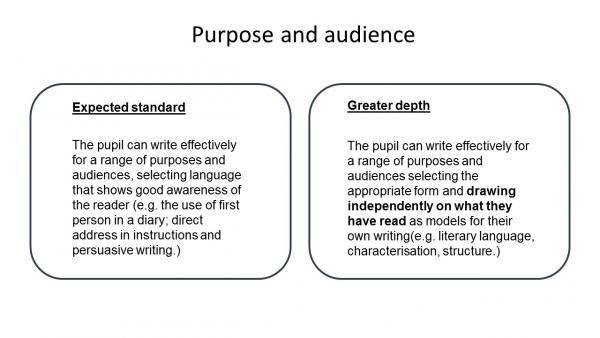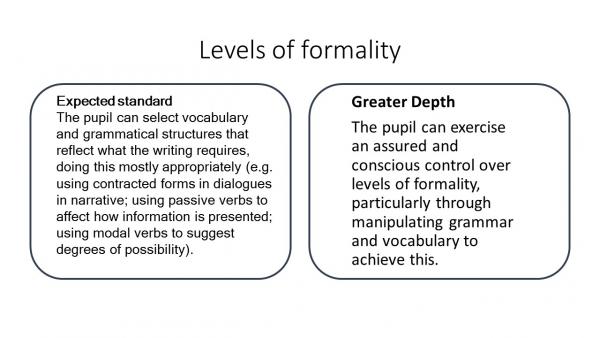Last summer, post SATs, the Hertfordshire team of KS2 moderators visited 119 schools over three and half weeks. As always, it was an intense and time pressured period but one that also offers a window into what is happening with regard to writing in a diverse range of schools. Now that some time has passed, I have been able to collect and compile, not only my own thoughts, but also those of many of the KS2 moderators and some of the headteachers who received a Moderation visit. Some common threads emerge that are worth sharing so that they can help to inform our planning and teaching of writing this year. I also hope that in sharing these findings, they can allay some of the anxieties that staff feel when they hear that they are to be moderated. To this end, the Assessment team have also produced a short document Year 6 checklist – writing teacher assessment that we hope will further support teachers with both their understanding of the revised Teacher Assessment Framework (TAF) and the requirements of moderation.
Lesson number 1: Write away!
Carry on writing before, during and after SATs
It is understandable to want to focus on some SATs test preparation before the SATs test window. However, where this takes place at the expense of continued writing opportunities, this does impact on the number of writing pieces available and hence writing results. It is often from April onwards that a child is able to more independently apply the teaching from the autumn and first part of the spring term and really show us what they can do. Ideally, the majority of your evidence for the majority of your pupils would be drawn from the later part of the year where you can revisit, for example, the effective use of dialogue or features of formal writing that were taught in a more scaffolded way in the first part of the year. Having this bank of evidence from the later part of the year is key to the success in achieving the ‘pupil can’ statements independently.
Best practice saw schools where extended writing and editing was the norm. Moderators often reported a copious range of quality writing, often with two or even three literacy books filled per child – although the left hand page may be left blank for improvements or writing tips. Other schools may divide writing across folders and subject books. It is not about how the work is presented, but it is about ensuring there is sufficient writing to meet all the ‘pupil can’ criteria.
In one school, the moderator was impressed by the school’s cross-curricular approach to their writing. The moderator felt that it showed a really good emphasis on writing in all lessons.
In many schools moderators praised the good choices of quality texts that were inspiring the children and raising the standard of writing produced. Furthermore, many moderators commented on the passion shown by staff for writing and books. Moderators saw many staff really encouraged writing through a love of reading widely and plenty of role play and talk for writing. Moderators also commented on the skilful teaching of grammar through reading and through the children’s own writing, rather than taking up time with too many discrete grammar exercises. (It is worth remembering that the GAPS test does not form part of the school’s headline accountability measure, while the writing TA does.)
It is a privilege and an inspiration to moderate in these schools and there is much to celebrate – not least the enthusiasm, subject knowledge and skill of the Year 6 teachers.
Lesson number 2: Who are we writing for?
Consider the range of writing opportunities offered to ensure that they cover a range of purposes and audiences – both formal and informal.
Keep in mind the following four ‘pupil can’ criteria (as they work together) when planning the writing for the year:


Basically, pupils need to be able to know the purpose and audience for the writing, and hence select appropriate language and sentence structure to fit the purpose and audience. So what types of tasks/genres should a teacher cover in Year 6?
To answer this question, it is worth looking at the exemplification and considering the range of tasks and the purpose and audience for each task in each collection. Let’s look, for example, at the tasks included in Morgan’s collection:
Morgan: EXS exemplification
Piece A: A short story
What is the audience and purpose? Probably any person over 10 years old who wants to be entertained/intrigued/spooked.
So the writer needs to include cliff-hangers/time-shifts, interesting characters, literary techniques, dialogue that both moves the story forward and reveals character etc. If the pupil can do this, they will be meeting the ‘pupil can’ statements above (differentiated by outcome).
Piece B: A recount
What is the audience and purpose? To inform parents about the Viking day.
This can be written informally, in a chatty and conversational style, as it is for a familiar audience. However, it will also need a level of detail to make it of interest, and technical vocabulary that may need to be explained.
Piece C: A letter
Who is the audience/ what is the purpose? This is a formal letter to the workshop leaders, to thank them and give recommendations. Pupils might be expected to make more use of passive constructions, modals, nominalisation, abstract nouns and succinct word choice (e.g. discover rather than find out) etc.
Piece D: Short story
This piece deliberately mimics literacy techniques used in the play Macbeth.
Piece E: Balanced argument
Who is the audience/ what is the purpose? The intended audience is the Local Council, in order to present their own views.
Again, this is another piece of writing with a formal tone. We might expect the features of formal writing to be evident and some direct address to the reader.
Piece F: Science investigation
A formal write up – we would expect passive voice, headings etc.
Looking across the pieces, you can see that there are opportunities to write for different purposes and audiences – and hence the writing will need to be appropriate to both task and audience. You don’t need to complete the same tasks – however you do need to allow opportunities for pupils to write both formally and informally as appropriate to a range of audiences and purposes. Consider, for every writing task, what the purpose is for the task, and who the audience is. Then consider what features – types of language and vocabulary – the writing might contain for these different audiences and purposes.
In the main, pupils tend to write ‘down the middle’: neither formally nor informally. It is the formal that most will struggle with. Therefore, we need to model and provide opportunities for formal writing, and then show where else this could be used – for example, a character in a story that is trying to assert their authority over others may speak more formally.
The trick is not necessarily to tell pupils to include a long list of features – but to consider purpose and audience and find some good model text. Above all, the writer needs to be able to write with the reader in mind – does it make sense? Can the reader follow it? Could I/should I phrase or structure any parts differently to make it more effective or easier to follow for the reader?
Lesson number 3: Ease up on the scaffolding as you go through the year
There need to be an adequate number of independent pieces of writing. For schools using a ‘Talk for Writing’ type approach, the writing, at least towards the end of the year, needs to be at the ‘innovate’ stage and not be heavily modelled. If a number of children in the class have very similar sounding pieces it is hard to use this as evidence for a ‘pupil can’ statement (unless independently applied by the child elsewhere.)
This also applies to teacher feedback – ease up on being too directive as the year progresses. For example, instead of pointing out a spelling or grammatical error, give pupils time to find them and correct them independently.
Lesson number 4: Take time to understand the new criteria for greater depth and what this looks like in the writing
One of the main strands emerging this year regarded securing and accurately assessing ‘greater depth’ – perhaps not surprising given the changes to the TAF last year. The revised ‘pupil can’ statements for greater depth represent the greatest change. Given these changes, and the fact that teachers only have one exemplification portfolio for GDS (Frankie), it is not surprising that it is difficult to decide on the ‘cuspy’ children.
It would seem that the 'pupil can' statement that was hardest to evidence was the statement regarding ‘assured and conscious control over levels of formality’. At the STA training for Lead Moderators, the STA stated that:
Pupils working at ‘greater depth’ must demonstrate the ability to manipulate grammar and vocabulary according to the context of the writing. The emphasis on ‘assured and conscious control’ refers to the fact that choices made in their writing are deliberate and considered.
Obviously, writing such as ‘Frankie’s’ clearly meets this statement - but how ‘assured and conscious’ do our Year 6 writers need to be? Here it is worth turning to the ‘Leigh’ exemplification file as a benchmark as Leigh only narrowly misses the greater depth standard. There is one piece – piece B – where Leigh is able to meet the ‘assured and conscious control’ statement. If your pupil can write like piece B more often, then they are in with a chance of being at ‘Greater depth’. The annotations on the remaining pieces show where Leigh has been less consistent and hence why the award remains at expected standard.
Reflect too, as you read the collection, on the purpose and audience for each piece in the collection. Are there enough opportunities for Leigh to write formally? Could more opportunities for formal writing have helped to lift Leigh into ‘Greater depth’? Does the recount provide any evidence for Greater depth? (No!) Additionally, has Leigh been given adequate time to re-draft some sections of her work to consider precision of language, or tidy up punctuation? The implications are that greater depth writers may need longer to craft their writing, as well as more exposure to a range of reading material and a range of tasks that have a clearly defined purpose and audience.
Lesson number 5: Spelling matters
Moderators see the Year 3/4 spellings misspelt more often than the words from the Year 5/6 statutory word lists. This is mainly because, as Year 6 teachers know, Year 6 pupils rarely use the words from the Year 5/6 spelling lists in their writing, whereas they do use the words from Year 3/4. In addition, half the words on the Year 5/6 statutory word lists are, in fact, easier for pupils to spell than many of the Year 3/4 words. These Year 5/6 words do need to be evidenced, but they can be evidenced through spelling tests or dictation, if they are not naturally occurring in pupil writing.
Therefore, crack the Year 3/4 words before the Year 5/6 as these are the ones the pupils use most in their writing. Model how to spell when modelling writing. “What spelling rule do I need to remember? What could I do to try to spell this word? Where could I get help?” etc.
Remember too that pupils should be using dictionaries and thesauruses in order to help them to use and spell more ambitious vocabulary choices.
To finish, let’s step back and think about each standard. A key question must be:-
What commonly stops pupils being the standard above?
Where pupils failed to meet the ‘working towards’ statements, they often had difficulty with sentence punctuation and spelling.
Where pupils failed to meet the ‘expected standard’, they often had difficulty with cohesion and writing for a range of purposes (mainly falling down on formal/ variation of sentence structure.) Spellings (frequently still Year 3/4) were often an issue. Watch out too for the comma splice.
Where pupils failed to meet the ‘greater depth’ standard, they may not have demonstrated the accurate (and considered) use of the range of punctuation, nor the conscious control over levels of formality required.
Given these difficulties, it can be useful to read pupil drafts, and place writing into three piles:
- writing that would most benefit from feedback around sentence construction/ punctuation
- writing that would most benefit from input around cohesion, and
- writing that would most benefit from feedback around word choice (particularly for more formal/academic writing. Consider too the importance of verb form).
The following day, offer conference feedback to a group at a time. Meanwhile pupils not working with you could be given various writing or editing tasks – including reviewing spellings. (Ask pupils to read their work word by word backwards from the end in order to notice any spelling errors.)
Finally, as Lead Moderator for KS2 writing, I would genuinely like to express my gratitude to all the schools that we visited. Despite the fact that the visits are compulsory, the warmth of welcome never fails to endear and impress. As I am sure the moderating team will concur, it is a privilege to spend time in so many schools with staff who really care, just as it is a privilege to read the thoughts and words of so many 10 and 11 year olds.
Read more: Reflections on the 2022 moderation at both Key Stages 1 and 2.



